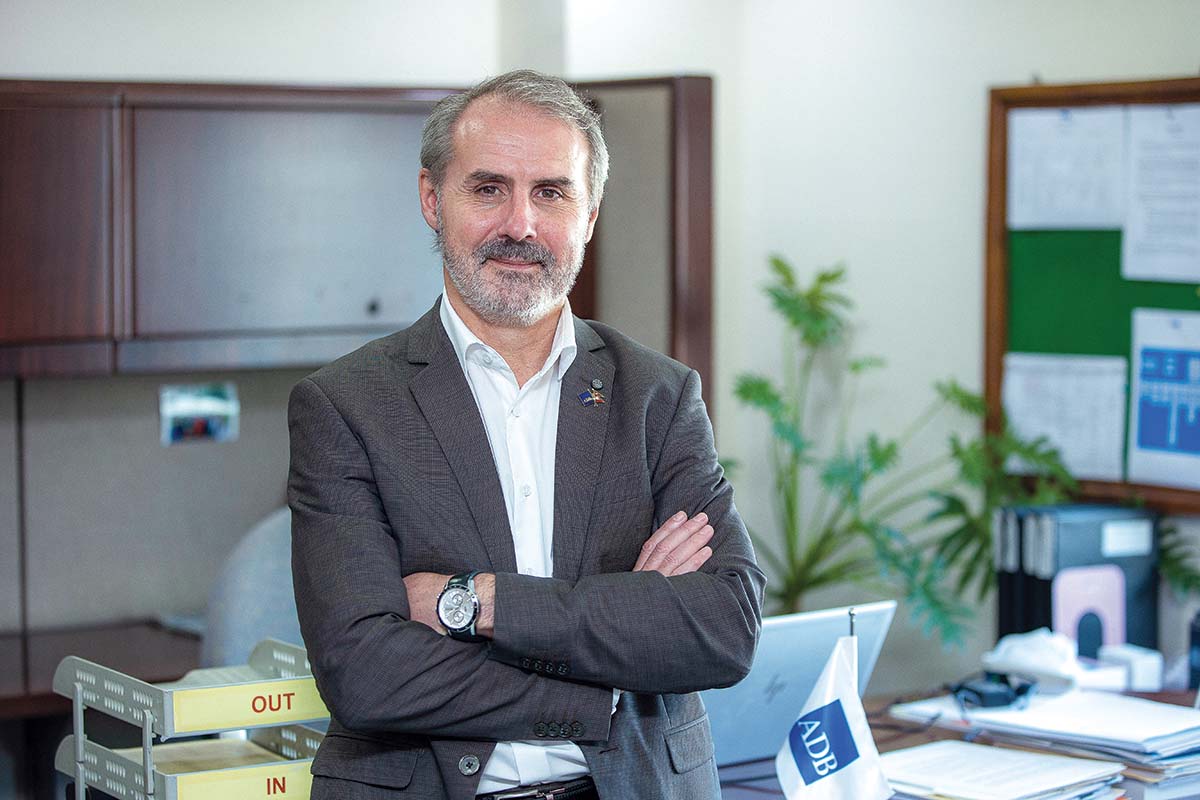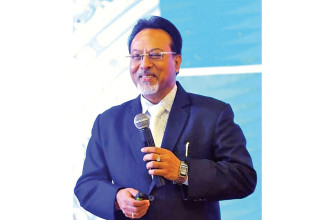
ADB’s Country Partnership Strategy (2020-2024) focuses on three priority areas: improving infrastructure for private sector-led growth, improving access to devolved services, and ensuring environmental sustainability and resilience. The multilateral development bank is now gearing up to frame its new Country Partnership Strategy for the next five years.
In this context, Business 360 caught up with Arnaud Cauchois, ADB’s Country Director for Nepal to learn about the priorities of engagement in Nepal going forward. Excerpts:
What are your recommendations to the government to cope with the current economic challenges of the country?
My foremost recommendation to the government would be to accelerate the execution of capital expenditure budget. The fiscal policy reflected in the budget speech for 2024 had pledged to mend the past budget implementation issues and challenges through the finalisation of the work plan and issuance of work manuals and directives. But progress seems far-fetched as reflected by the poor capital budget execution at around 12% in the first five months of this fiscal year. In the current scenario of economic challenges, whereby construction activities have slowed down, it is imperative that the government ramp up public investment to stimulate the economy. This will also induce confidence in the private sector, thereby promoting private investment.
The second recommendation would be to ensure good coordination among line agencies and that agencies be held accountable for failing to comply with the promised deliverables within the stipulated timeframe. In the absence of accountability, development process has derailed in Nepal.
And the third recommendation would be to bring private sector into confidence by facilitating the business environment, ensuring fair and predictable tax regime, and implementing various measures such as industry registration, dissolution, and investment approval electronically, among others.
In the medium to longer term, the government must aim at enhancing its domestic production and generating employment opportunities. These can be achieved if the government facilitates commercial farming, promotes micro and small medium enterprises, and advances information and technology, and tourism businesses. The government should also continue the rationalisation of recurrent expenditures to minimise the widening budget deficit. It should implement project banks and medium-term expenditure frameworks at provincial and local levels for making project development and selection systems more systematic and transparent.
With Nepal being in the process of graduating from Least Developed Country to Developing Country by 2026, how does ADB envision supporting Nepal?
Nepal qualified for graduation to a developing country status as it met two out of three thresholds - on human assets and economic vulnerability - to become eligible for graduation. It did not meet the gross national income (GNI) per capita criterion. Once it graduates, Nepal will not be eligible for the benefits that LDCs are provided by the international trading system. For graduation from LDC status to become sustainable, Nepal needs to achieve inclusive and high economic growth as envisaged in its 15th five-year plan (FY2020-FY2024) and its long-term vision for 2043. Nepal has an extended preparatory period of five years to prepare itself for graduation. Now the focus should be on achieving a green, resilient, and inclusive development to achieve high and sustained rates of economic growth. This will require structural reforms and quality investments in physical and human capital to stimulate greater private sector investment including foreign direct investment; raise productivity in agriculture, manufacturing, and services; and increase and diversify exports of goods and services in terms of products and markets. ADB is committed to supporting the government of Nepal in all of this.
ADB’s support in the coming years is geared toward supporting the government’s Green, Resilient, and Inclusive Development Strategy which takes a proactive approach to addressing structural issues and emphasises long-term green and sustainable growth, climate action, and resilience in the face of multiple risks. It comprises policy and institutional reforms, critical investments in infrastructure and human capital, and institutional capacity development along with context-specific innovation including digitalisation and knowledge solutions. Some of the areas of ADB support include customs and logistics reforms, public financial management and devolved service delivery, sector reforms in agriculture, aviation, and water supply. Other support includes upgrading the East–West Highway and the Tribhuvan International Airport, water supply and other urban infrastructure in the Kathmandu valley and other cities and towns, Dudh Koshi [storage] hydropower generation project, and high-capacity lines for domestic and regional power transmission; education and skills development; agriculture, rural connectivity, and irrigation. These would help crowd in private sector investment, raise productivity and economic competitiveness, and provide vital services to businesses, communities, and households.
Could you tell us about ADB partnership with the Government of Nepal in the energy sector and the progress of the Tanahu Hydropower Project?
ADB has been a longstanding partner in Nepal’s energy sector since 1972. Nepal’s energy sector has come a long way since then. The nation that once suffered from chronic power shortages has now started selling surplus electricity on the Indian energy trading platform. This is a significant achievement.
Today, Nepal is generating electricity in excess of its domestic demand in the wet season. More households and industries have access to grid electricity, and private investment in hydropower generation has surged. It is heartening to see these transformations and ADB is immensely proud to have been a long-standing partner of the Government of Nepal in the energy sector.
In this partnership of over 50 years, we have seen many milestones. With ADB support, Nepal was able to build its first 132kV transmission line in the 1970s. Nepal also built the first hydropower project of over 100 MW with ADB’s financial and technical assistance. The 144MW Kali Gandaki ‘A’ Hydropower Project commenced operation in early 2000s when electricity demand–supply mismatch led to frequent power cuts. It remains one of the largest power plants in the country.
We have seen significant progress in the construction of Tanahu Hydropower Project, and it has reached an approximate completion rate of 47%. Although the project did face some delays, it is now on track to be completed by the year 2026. The project is expected to generate 140 MW of electricity round the year. It’s a reservoir type project, the electricity generated by this is expected to be smooth and uninterrupted. The project is expected to contribute to the increased level of economic activities in the country via more and regular electricity supply.
I was in Nawalparasi for the inauguration of Kushma-New Butwal 220kV transmission line on 11 December. I congratulated the Government of Nepal; Ministry of Energy, Water Resources and Irrigation; Nepal Electricity Authority; and all the stakeholders on successful completion of a significant portion of the Kali Gandaki corridor transmission line which includes the previously completed substations at Dana, Kushma, and New Butwal. I am happy to note that private sector investment for hydropower development has gained momentum in Kali Gandaki river basin with the construction of this transmission line. I understand there are more than a dozen 300-megawatt hydropower projects currently under development and some have reached an advanced stage of completion.
With the completion of this transmission line, which is connected to the New Butwal substation, one of the proposed points for cross-border power trade with India, Nepal will be able to harness its resources for development and contribute to increasing the share of clean energy in the South-Asia region. Additionally, the industrialising Butwal–Bhairahawa area will benefit from the power supply originating from the Himalaya and the hills.
With the Nepal government’s decision to start the construction of the Dudh Koshi Storage Project in coordination with ADB, when can one expect construction to begin?
ADB and the World Bank Group signed a memorandum of understanding stipulating cooperation and collaboration to strengthen Nepal’s hydropower sector, specifically in the context of the proposed Upper Arun and Dudh Koshi hydropower projects. The MoU for an initial period of five years was signed on December 6 on the sidelines of COP28 by ADB Vice-President for Sectors and Themes Fatima Yasmin and World Bank Vice-President for South Asia Martin Raiser.
The pilot approach between the two multilateral development banks (MDBs) provides opportunities for collaboration in knowledge and experience sharing to ensure common understanding of the hydropower sector in Nepal, joint analytical studies, and consultation in support of the development of the hydropower sector.
Under the MoU, ADB and the World Bank Group will also work together on strengthening the institutional capacity of Nepal’s executing and implementing agencies in the development of large hydropower projects, and the preparation and financing of these two projects. This is the first MoU signed between ADB and the World Bank Group following the joint statement on strengthening collaboration for greater impact issued by the heads of MDBs at the World Bank Group–International Monetary Fund Annual Meetings in Marrakesh in October. The MoU specifically targets three critical areas for collaboration: enhancing country-level collaboration, strengthening co-financing, and boosting joint action on climate change.
The project has been earmarked within the ADB pipeline for 2024, contingent upon its readiness.
What will be ADB’s future climate change strategy, including in Nepal?
As the climate bank for Asia and the Pacific, ADB has significantly raised ambitions to deliver climate finance to developing member countries, targeting $100 billion between 2019 and 2030. To further accelerate our efforts, ADB is piloting the Innovative Finance Facility for Climate in Asia and the Pacific (IF-CAP), leveraging guarantees and grant contributions from financing partners and philanthropies to generate $4 for every $1 invested. We are also actively engaging the private sector in delivering climate solutions.
In Nepal, ADB supports the Strategic Programme for Climate Resilience. We have also helped facilitate $70 million in financing to improve the livelihood and climate resilience of Nepali farmers in five provinces, with a project that will boost the productivity of 30,000 farming households, mainly by developing around 10,000 hectares of climate-resilient orchards. Nepal was one of the first countries to submit its updated nationally determined contribution (NDC) under the Paris Agreement, and ADB is proud to support the country in achieving its NDC goals by helping mainstream climate change and mobilise resources and financing. ADB Nepal is currently engaging in three interesting projects. The Building Adaptation and Resilience in the Hindu Kush Himalayas (HKH) initiative that addresses geo-physical and climatic risks in the HKH regions, the Green and Resilience Financing Facility that aims to bridge gaps for NAP implementation, and the third project is the budgetary support project to the Government of Nepal that focuses on reforming policies and regulations related to climate change, environment and disaster issues facing Nepal. Let us bear in mind that our primary agenda is poverty alleviation but to be successful, we need to ensure that development is low-carbon and climate-resilient.
Could you tell us about ADB’s Hindu Kush Himalaya Climate Risk Management Initiative?
The Building Adaptation and Resilience in the Hindu Kush Himalayas was launched at COP28 by Nepal’s Minister of Forests and Environment. The initiative will help assess and manage climate and disaster risks in the Hindu Kush Himalaya region, a critical water tower supporting the livelihoods of more than a billion people across Asia. Through this technical assistance, ADB will undertake deep analysis of multi-hazard risks which include landslides, earthquakes, and floods - including from glacier lake outbursts - and vulnerabilities in Bhutan and Nepal. This will help to strengthen the two governments’ capacities to conduct risk assessments in priority river basins. These assessments will be used to develop early warning systems and risk management options for future infrastructure development.
From 1985 to 2014, economic losses resulting from disasters in the Hindu Kush Himalayas region totalled $45 billion, much higher than those of any other mountain region. Since then, the increasing frequency and intensity of disaster events have pushed up economic losses and the number of people killed or displaced by such events. Governments and the private sector need to invest in climate resilience now to ensure hydropower facilities, roads and other kinds of infrastructure can sustainably meet the region’s growing demands.
ADB’s assistance will help the governments, private sector, and local communities to understand the risks they face so they can decide on disaster risk reduction and adaptation measures, as well as risk transfer solutions including insurance. The technical assistance will set up partnerships with regional and international technical institutes and academia to bridge knowledge gap across the Hindu Kush Himalaya region on climate resilient investment planning, development, and risk management.
How is ADB working to minimise the vulnerabilities of women, marginalised and ethnic minorities in the view of increasing climate induced catastrophes?
In Nepal, the adverse impacts of climate change disproportionately affect women and disadvantaged groups due to prevalent gender inequality and the exclusion of marginalised communities. Defined gender roles result in varying risk exposures and perceptions, along with differing abilities to respond between men and women. Moreover, women and disadvantaged groups encounter barriers such as limited access to productive assets, secure income sources, education, health facilities, and decision-making roles, rendering them more vulnerable to climate and disaster risks while constraining their adaptive capacity.
ADB’s Nepal Country Partnership Strategy for 2020-2024, aligned with Strategy 2030 operational priorities (OP) 1 - addressing persistent poverty and reducing inequalities, OP2 - advancing gender equality, and OP3 - combating climate change while enhancing climate and disaster resilience, along with the SARD GESI Framework 2022, offer directives for integrating Gender Equality and Social Inclusion (GESI) into ADB-supported projects. In project/programme design, ADB employs a participatory and inclusive approach, engaging women and disadvantaged groups (such as Dalits, persons with disabilities, sexual and gender minorities, and senior citizens) in stakeholder consultations. These consultations aim to understand the challenges these groups face due to climate change and disaster risks, subsequently providing support through project/programme interventions to bolster their resilience and adaptive capacity. Examples of such interventions include the development of GESI-responsive climate and disaster-resilient infrastructure, fortification of financial protection systems, community-based resilience initiatives, and targeted social assistance programmes tailored for women and disadvantaged groups.
But much more needs to be done. To strengthen women’s resilience to climate change and disasters, gender-responsive laws and policies are needed in addition to properly resourced, key actions - such as increasing women’s participation in decision-making, using sex-disaggregated data, and following guidelines on gender mainstreaming.
Is there any plan to open up private sector lending through ADB?
ADB is currently financing the 216 MW Upper Trihuli 1 hydropower project, along with eight other development financial institutions. We have been partnering with commercial banks to support trade transactions under our Trade Finance Programme. We are also close to signing a project to support the SMEs, including women-led SMEs, through a commercial bank. Likewise, ADB is exploring a potential partnership to implement its Microfinance Programme in the country. Similarly, through a technical-assistance project, ADB is seeking to generate lead for private-sector transactions in the areas of Nepal’s priority, including agriculture, tourism, clean energy, selected social sectors, etc.
In the upcoming Country Partnership Strategy 2025-2029, ADB expects to present its vision for private sector development, including policy reforms and strengthening operational environment for businesses. We plan to focus on upstream (policy/legal, regulatory) and midstream (project preparation) support to help generate viable financing opportunities. ADB is also in discussion with the government to support improving the PPP enabling environment and is exploring the potential to provide transaction advisory support. Going forward, ADB anticipates dedicated effort to support the transition to the green economy and expects the private sector to be a key player in this regard. We also aim to work with the private sector to mobilise greater climate finance resources as well as strengthen their capacity to prepare and implement green and resilient projects.






